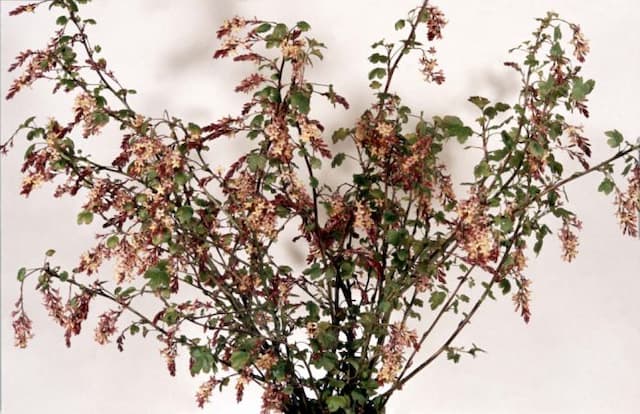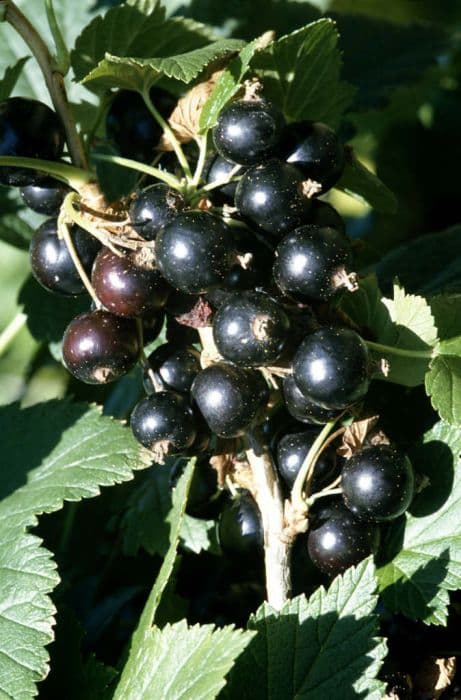Gooseberry Ribes uva-crispa 'Hinnonmäki Röd' (C/d)

ABOUT
The Ribes uva-crispa 'Hinnonmäki Röd', commonly known as the red gooseberry, is a fruiting shrub known for its productive and tasty berries. It typically bears deep red, medium-sized berries that are tart when unripe and become sweeter as they mature. The fruit is covered with a thin, translucent skin that may have some fine hairs, creating a slightly fuzzy texture. The foliage of the red gooseberry is made up of medium to dark green leaves that are lobed and resemble maple leaves in shape. These leaves often have serrated or toothed edges, adding a textural quality to the plant's appearance. The plant's stems are woody and may have sharp thorns that can make handling the plant a prickly experience. These thorns are an important feature to remember when pruning or harvesting. In spring, the red gooseberry produces small, insignificant flowers, typically of a pale greenish or sometimes reddish hue. These flowers are bell-shaped and give way to the developing fruit, which is the main attraction of the plant. The overall aesthetic of the Ribes uva-crispa 'Hinnonmäki Röd' combines the rustic charm of its thorny branches with the appealing roundness of its berries and the softness of its foliage, creating a plant that is both beautiful and productive in a garden setting.
About this plant
 Names
NamesFamily
Grossulariaceae
Synonyms
Hinnonmäki Röd Gooseberry, Red Gooseberry, Finnish Gooseberry
Common names
Ribes uva-crispa 'Hinnonmäki Röd' (C/d).
 Toxicity
ToxicityTo humans
The plant commonly known as gooseberry, specifically the Ribes uva-crispa 'Hinnonmäki Röd' variety, is generally considered non-toxic to humans. The berries are edible and commonly consumed. However, leaves and other parts of the plant may cause mild stomach upset if ingested in large quantities due to the presence of small amounts of oxalic acid and other plant compounds.
To pets
For pets, the common gooseberry plant (Ribes uva-crispa 'Hinnonmäki Röd') is also generally considered safe. Like in humans, the consumption of the berries is typically non-toxic to pets. However, consuming large amounts of the leaves or other plant parts can potentially cause mild gastrointestinal upset because of oxalic acid and other compounds in the plant.
 Characteristics
CharacteristicsLife cycle
Perennials
Foliage type
Deciduous
Color of leaves
Green
Flower color
Greenish-yellow
Height
3-5 feet (0.9-1.5 meters)
Spread
3-5 feet (0.9-1.5 meters)
Plant type
Shrub
Hardiness zones
5
Native area
Europe
Benefits
 General Benefits
General Benefits- Edible Fruits: The plant produces tasty, red gooseberries that can be eaten fresh or used in various culinary preparations, such as pies and jams.
- Garden Aesthetics: With its attractive green foliage and red fruits, it adds beauty and visual interest to gardens.
- Wildlife Attraction: The flowers can attract pollinators like bees, while the berries can attract birds and other wildlife.
- Easy Cultivation: 'Hinnonmäki Röd' is known for being hardy and relatively easy to grow, making it suitable for gardeners of various skill levels.
- Compact Growth: It has a compact growth habit, which makes it suitable for smaller gardens or for growing in containers.
- Drought Tolerance: Once established, it has good drought tolerance, reducing the need for frequent watering.
 Medical Properties
Medical Properties- Antioxidant: The fruit of Gooseberry 'Hinnonmäki Röd' contains vitamin C and other antioxidants which can help protect cells from damage caused by free radicals.
- Anti-inflammatory: Certain compounds in the gooseberry, such as anthocyanins, may have anti-inflammatory effects.
- Immune support: The high vitamin C content can contribute to the normal functioning of the immune system.
- Digestive health: Gooseberries have dietary fiber which aids in maintaining a healthy digestive system.
- Blood sugar regulation: The fruit might help in managing blood sugar levels due to its fiber content and potential impact on glucose metabolism.
 Air-purifying Qualities
Air-purifying QualitiesThis plant is not specifically known for air purifying qualities.
 Other Uses
Other Uses- Wildlife Habitat: The dense foliage of the gooseberry bush offers shelter and nesting sites for birds such as finches and warblers.
- Natural Dye: The berries of the gooseberry can be used to create natural dyes for textiles in shades of pink to purple, depending on the mordant used.
- Garden Design: With its attractive berries and foliage, gooseberry bushes can be used as ornamental plants in garden landscapes to create visual interest.
- Culinary Garnish: The bright, tart berries can be used as an edible garnish for desserts and cocktails, adding a pop of color and a punch of flavor.
- Photography Subject: The distinctive appearance of gooseberry bushes, with their hanging fruit and serrated leaves, makes them great subjects for botanical photography.
- Livestock Forage: In some countries, gooseberry bushes are used as a supplemental forage for livestock when other food sources are scarce.
- Craft Projects: The strong, flexible stems of the gooseberry can be woven into wreaths, baskets, and other craft items.
- Erosion Control: Gooseberry plants, with their extensive root systems, can be planted on slopes or areas prone to erosion to help stabilize the soil.
- Education: Gooseberry plants can be used in educational settings such as schools or botanical gardens to teach about plant lifecycles, pollination, and fruit development.
- Frost Indicator: In some rural farming practices, the blooming time of gooseberry plants is observed as an indicator of the last frost, helping farmers know when to plant sensitive crops.
Interesting Facts
 Feng Shui
Feng ShuiThe Gooseberry is not used in Feng Shui practice.
 Zodiac Sign Compitability
Zodiac Sign CompitabilityThe Gooseberry is not used in astrology practice.
 Plant Symbolism
Plant Symbolism- Nurturing: As a fruit-bearing plant, Ribes uva-crispa 'Hinnonmäki Röd', commonly known as the Gooseberry, symbolizes nurturing and care, relating to its ability to provide sustenance.
- Patience: The gooseberry plant requires patience to grow and bear fruit, making it a symbol of the patience needed in life or projects.
- Protection: With its thorny branches, the gooseberry is often associated with protection, suggesting a need for boundaries or defense.
- Gratitude: The abundance of the gooseberry harvest can symbolize gratitude for the bounties and blessings in one’s life.
 Water
WaterThe Gooseberry 'Hinnonmäki Röd' should be watered deeply, allowing the soil to be moist but not waterlogged. In general, watering should happen once a week, but frequency may need to increase during periods of drought or extreme heat to twice per week. It is best to water the plant early in the morning or late in the afternoon to reduce evaporation. Depending on the size of the plant and weather conditions, each watering session should provide the gooseberry with about 1-2 gallons of water.
 Light
LightGooseberry 'Hinnonmäki Röd' thrives in a position where it can receive full sun to partial shade. The ideal spot would be where the plant gets at least 4-6 hours of direct sunlight daily, which will aid in fruiting. However, some light afternoon shade can be beneficial, especially in areas with very hot summers.
 Temperature
TemperatureThe Gooseberry 'Hinnonmäki Röd' performs well in a wide range of temperatures but prefers a cooler climate. It can survive in winter temperatures as low as 20 degrees Fahrenheit, but the ideal growing conditions are between 60 and 75 degrees Fahrenheit. The plant requires chilling hours below 45 degrees Fahrenheit to set fruit but should be protected from extreme cold below 20 degrees Fahrenheit.
 Pruning
PruningPrune Gooseberry 'Hinnonmäki Röd' annually to maintain an open, upright habit and to facilitate good air circulation, which helps prevent diseases. The best time to prune is in late winter or early spring before new growth starts. Remove any dead or diseased wood, and thin out the center of the bush to allow sunlight to reach all parts of the plant. Typically, pruning can happen once a year, but light trimming may occur as needed during the growing season to shape the bush or remove damaged branches.
 Cleaning
CleaningNot needed
 Soil
SoilGooseberry 'Hinnonmäki Röd' thrives in well-draining, loamy soil enriched with organic matter; aim for a soil pH of 6.0 to 6.5 for optimal growth.
 Repotting
RepottingGooseberry 'Hinnonmäki Röd' plants grown in pots should be repotted every 2-3 years to replenish soil nutrients and provide room for growth.
 Humidity & Misting
Humidity & MistingGooseberries, including 'Hinnonmäki Röd', are adaptable but prefer moderate humidity levels outdoors; they do not have specific indoor humidity requirements.
 Suitable locations
Suitable locationsIndoor
Grow in bright light, cool room, water when topsoil is dry.
Outdoor
Plant in sun/partial shade, protect from strong winds and frost.
Hardiness zone
3-8 USDA
 Life cycle
Life cycleThe life of the plant commonly known as Gooseberry 'Hinnonmäki Röd' begins with seed germination, which takes place in the soil under appropriate temperature and moisture conditions. After germination, the seedling emerges and develops into a young plant with leaves, which undergoes vegetative growth to establish a root system and foliage. This perennial shrub then enters a stage of maturity where it produces flowers annually, typically in the spring, followed by pollination—often facilitated by insects—that leads to the development of the characteristic gooseberries. Once the fruit ripens, typically in early summer, they can be harvested, and their seeds can disseminate to give rise to new plants. Over the years, the Gooseberry 'Hinnonmäki Röd' shrub can produce fruit repeatedly through seasonal cycles, while potentially undergoing pruning and cultivation to maintain plant health and productivity. With the right care and conditions, the gooseberry bush can live and bear fruit for many years before eventually completing its life cycle and dying.
 Propogation
PropogationPropogation time
Spring-Early Summer
Propogation: The most popular method of propagating the Gooseberry 'Hinnonmäki Röd' is through hardwood cuttings. This is typically done in late fall after the leaves have dropped or in early spring before bud break. Cuttings should be about 6 to 8 inches (15 to 20 centimeters) long and include at least three buds. The lower cut should be made just below a bud, and the upper cut should be made just above a bud to maximize potential growth. The cuttings are then planted in well-draining soil with two-thirds of their length below the surface. To enhance rooting, the base of the cuttings can be dipped in rooting hormone powder before planting. It generally takes a few weeks for roots to establish, after which the new plants should be carefully monitored to ensure successful establishment.








